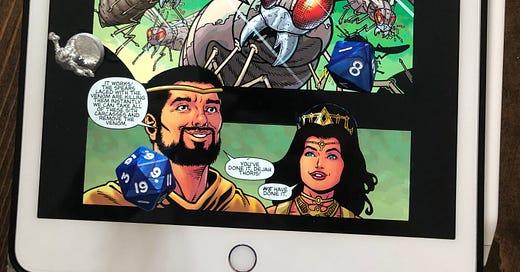
Late at night, those living beneath the thick canopies of the steaming, equatorial rainforests tell stories of flying monstrosities that emerge from the trees to slay or carry off unsuspecting men, women, and children. They say these predators have wandered far, from an even more savage homeland, and hate all creatures found in our world—for they are strangers to it.
At first glance, the vespine horror appears to be a shimmering, blue-black wasp the size of a large bull. Those who survive encounters with these creatures long enough to make a closer inspection, however, discover bodies of flesh and bone, rather than the chitinous make-up of most insectoid species. Lean muscle stretches beneath slick, black, hairless skin on six multi-jointed legs. Two broad, jagged teeth form a great, mandible at the front of the skull. The abdomen is covered with a beautiful, iridescent pelt, which shifts in the light between dark shades of blue, green, and red. At the end of the abdomen is a wickedly sharp stinger, made of tough horn, supplied with venom by two internal sacs.
The vespine horror’s most insect-like features are its eyes and wings. Due to the omnidirectional vision of the enormous compound eyes covering the majority of its head, the creature may only be surprised on roll of 1 on a d6. Its vast, semitransparent wings allow it to hover in place, despite its weight, or to move much faster than its typical prey.
In combat, a vespine horror prefers to grapple and sting. A successful grappling attack does no damage, but immobilizes the target, permitting a sting attack at +2. If successful, a sting does 1d4 points of damage, and the target must save vs. Poison or die. The creature will not willingly release its grapple until its target is dead, but the target may break the grapple with a successful save vs. Paralysis.
If a melee opponent’s attack roll against the creature totals 20 or more, after all adjustments, the opponent has severed, or otherwise disabled, the stinger (except when using a lance—see below). The creature may continue to bludgeon grappled opponents with the tip of its abdomen, now doing 1d8 damage (since it must no longer protect the delicate stinger), but the target is no longer required to save vs. Poison.
A vespine horror that is not currently grappling a target may forgo its grapple and instead kick with one of its two strong back legs. A successful kick does 1d8 points of damage.
In addition to the above attacks, the monster can bite with its mandible once each round. A successful bite does 1d8 points of damage.
The surest way to kill a vespine horror is to coat a lance in venom from one of its own kind, then strike its heart. When using a poisoned lance, an attack roll of 20, after all adjustments, means the lance has hit the heart. In addition to taking normal damage, the creature must save vs. Poison or die. A lance that is not poisoned does normal damage on a successful hit, but does not force a save. Because of their specialized nature, lances—unlike other melee weapons—are not useful to disable the stinger.
When others engage vespine horrors in combat, these creatures will always fight to the death. They are rumored to be nearly extinct in their home world. Perhaps this is why.
The vespine horror’s “treasure” consists of its venom sacs and its pelt. Once removed, the venom sacs can be sold to an interested alchemist for 350 gp, while a tanner will pay 1000 gp for the hide.
Armor Class: 3
Hit Dice: 8*
Move: 90’ (30’)
Flying: 240’ (80’)
Attack(s): 1 grapple or 1 kick/1 sting or 1 bludgeon/1 bite
Damage: 1d8/1d4 + poison or 1d8/1d8
No. Appearing: 1d2
Save As: Fighter 4
Morale: 12
Treasure Type: E
Alignment: Neutral
XP: 1200
N.B. Vespine horrors are inspired by the sith of Barsoom, in Edgar Rice Burroughs’ The Warlord of Mars.



